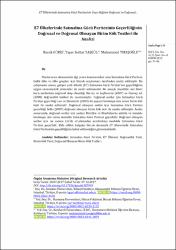| dc.contributor.author | Güriş, Burak | |
| dc.contributor.author | Yaşgül, Yaşar Serhat | |
| dc.contributor.author | Tıraşoğlu, Muhammed | |
| dc.date.accessioned | 2018-12-11T07:31:33Z | |
| dc.date.available | 2018-12-11T07:31:33Z | |
| dc.date.issued | 2018-02-01 | |
| dc.identifier.issn | 2148-4287 | |
| dc.identifier.issn | 2148-7189 | |
| dc.identifier.uri | https://hdl.handle.net/11363/441 | |
| dc.description | DOI: 10.17336/igusbd.387999 | en_US |
| dc.description.abstract | Uluslararası ekonominin ilgi çeken konularından olan Satınalma Gücü Paritesi, farklı ülke ve ülke grupları için birçok araştırmacı tarafından analiz edilmiştir. Bu çalışmanın amacı, gelişen yedi ülkede (E7) Satınalma Gücü Paritesi’nin geçerliliğinin uygun ekonometrik yöntemler ile analiz edilmesidir. Bu amaçla öncelikle reel döviz kuru serilerinin doğrusal olup olmadığı Harvey ve Leybourne (2007) ve Harvey vd. (2008) doğrusallık testleri ile incelenmiştir. Doğrusal seriler için Satınalma Gücü Paritesi geçerliliği Lee ve Strazicich (2003) iki yapısal kırılmaya izin veren birim kök testi ile analiz edilmiştir. Doğrusal olmayan seriler için Satınalma Gücü Paritesi geçerliliği Sollis (2009) doğrusal olmayan birim kök testi ile analiz edilmiştir. Analiz sonucunda, doğrusal seriler için sadece Brezilya ve Hindistan’da sabitte ve trendde kırılmaya izin veren modelde Satınalma Gücü Paritesi geçerlidir. Doğrusal olmayan seriler için ise sadece Çin’de ortalamadan arındırılmış modelde Satınalma Gücü Paritesi geçerlidir. Elde edilen bulgular birçok durumda E7 ülkelerinde Satınalma Gücü Paritesinin geçerliliğinin kabul edilmediğini göstermektedir. | en_US |
| dc.description.abstract | Purchasing Power Parity has been one of the most popular topics in international economy and has been studied by many researchers for different countries and country groups to date. The purpose of this study is to analyze the validity of the Purchasing Power Parity in emerging seven countries (E7) using relevant econometric methods. The Harvey and Leybourne (2007) and Harvey et al. (2008) linearity tests have been used to investigate the linearity of real exchange rate series. The validity of the Purchasing Power Parity was analyzed using the Lee and Strazicich (2003) unit root test that allows for two structural breaks for linear series. The Purchasing Power Parity for nonlinear series was analyzed using the Sollis (2009) nonlinear unit root test. As a result of the analysis, purchasing power parity is valid only for the model that allows for breaks in both the level and trend in Brazil and India for linear series. Purchasing power parity is valid only in the demeaned model for China. The findings indicate that the validity of the Purchasing Power Parity is not accepted for E7 countries in many cases. | en_US |
| dc.language.iso | tur | en_US |
| dc.publisher | İstanbul Gelişim Üniversitesi Yayınları / Istanbul Gelisim University Press | en_US |
| dc.rights | info:eu-repo/semantics/openAccess | en_US |
| dc.subject | Research Subject Categories::SOCIAL SCIENCES | en_US |
| dc.title | E7 Ülkelerinde Satınalma Gücü Paritesinin Geçerliliğinin Doğrusal ve Doğrusal Olmayan Birim Kök Testleri ile Analizi | en_US |
| dc.title.alternative | Analysis of the Validity of Purchasing Power Parity in E7 Countries Through Linear and Non-Linear Unit Root Tests | en_US |
| dc.type | article | en_US |
| dc.relation.publicationcategory | Makale - Ulusal Hakemli Dergi - Kurum Yayını | en_US |

















